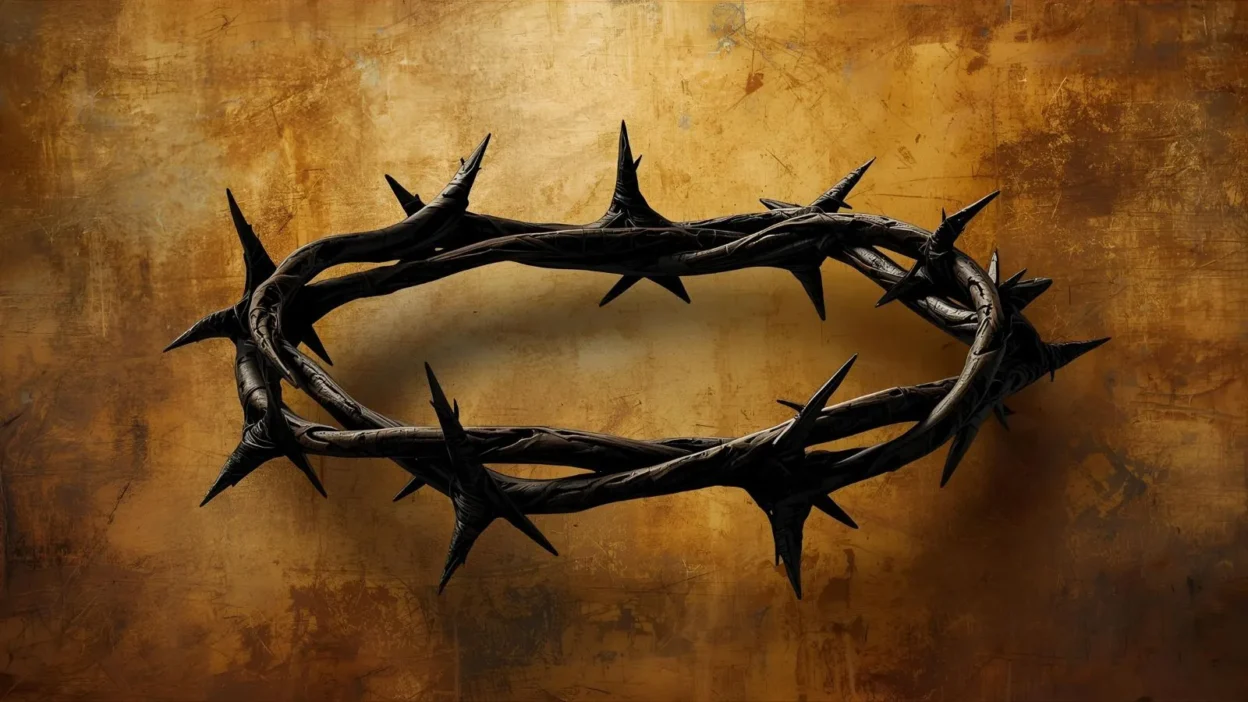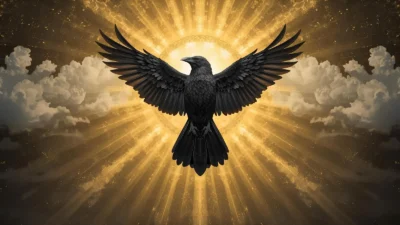When Anna lost her job, she spiraled into a storm of shame and fear. One night, while walking through her neighborhood, she spotted a crown of thorns plant blooming fiercely despite the dry, cracked soil beneath it. It looked both painful and powerful — a message in plain sight. That moment struck her. Could pain carry purpose? Could her suffering, like those sharp thorns, have spiritual meaning?
The crown of thorns has been a symbol of suffering, sacrifice, and redemption for centuries. Whether you see it in Christian imagery or even films like Dead Poets Society, it speaks to the deeper spiritual journey we all take. Let’s explore what this powerful symbol means for your emotional healing, spiritual growth, and personal transformation.
Jesus Crown of Thorns Symbolism
The crown of thorns placed on Jesus during His crucifixion is one of the most heart-wrenching and sacred symbols in Christianity. The Roman soldiers wove this cruel crown to mock His claim of kingship — but spiritually, it became a crown of divine humility and ultimate love.
In the Gospels, Jesus is presented as the “King of the Jews.” But instead of wearing a golden crown, He wore thorns — sharp, painful reminders of human cruelty, but also of His willingness to bear suffering for the sake of others.
It represents:
- Mockery turned into Majesty – What was meant as humiliation became a symbol of divine power.
- Painful Redemption – Every thorn stands for the emotional and physical suffering He bore for humanity.
- Spiritual Authority through Sacrifice – Unlike earthly kings, His authority comes not from force, but from love and surrender.
For those going through deep suffering, remembering the crown of thorns is a way to see purpose in pain, and to trust that wounds can become sacred.
Crown of Thorns Symbolism Meaning
At its core, the crown of thorns symbolizes the paradox of pain and glory. It blends the harshness of suffering with the nobility of endurance. Whether you see it in nature (like the Crown of Thorns plant) or religious art, its meaning remains spiritually rich.
Here are some emotional and spiritual meanings:
- Burden and Beauty – Pain doesn’t cancel beauty. Just like roses have thorns, growth often comes with discomfort.
- Sacrifice – It reminds us that true love is sacrificial. Whether it’s a parent, teacher, or friend, giving deeply can sometimes hurt.
- Protection and Boundaries – Thorns are nature’s way of defending what’s precious. Spiritually, they ask: What are you guarding? What are you enduring for the sake of your heart’s truth?
In dreams and meditations, seeing a crown of thorns may mean you’re in a season of transformation. It’s uncomfortable now, but there’s a holy purpose unfolding.
Jesus’ Crown of Thorns Symbolism
There’s a subtle but powerful shift in saying “Jesus’ crown of thorns.” It personalizes the suffering. It isn’t just any crown — it’s His. It belonged to the one who chose love over comfort, service over control.
This phrase deepens our emotional connection to His sacrifice:
- Ownership of Suffering – Jesus didn’t resist or escape the pain. He embraced it. Spiritually, this asks us: Can we face our wounds with that same bravery?
- Identification with Humanity – His suffering wasn’t abstract. It was real, bodily, and brutal. This means that in your loneliest, hardest moments, you are not alone.
- The Power of Voluntary Surrender – Jesus wasn’t defeated by the crown of thorns — He transformed it. The symbol becomes one of spiritual victory over earthly pain.
Wearing your emotional scars like a crown means you’ve endured, and there’s beauty in that story.
Crown of Thorns Symbolism Dead Poets Society
In the film Dead Poets Society, the theme of suffering for truth and authenticity plays heavily. Mr. Keating, the beloved teacher, can be seen symbolically bearing a crown of thorns. Though never literal, his role reflects a Christ-like figure — leading his students into a new kind of awakening, only to be scapegoated and punished for it.
Here’s how the symbolism plays out:
- Sacrifice for Others – Like Jesus, Mr. Keating sacrifices his comfort and career for his students’ growth.
- Emotional Persecution – He is misunderstood and blamed, though his intention was love and truth.
- Thorns of Truth – The cost of living authentically often includes rejection or pain — but that pain bears fruit.
The crown of thorns here represents emotional and moral suffering for the sake of truth. Watching Keating endure with dignity invites us to ask: Am I brave enough to live my truth, even if it hurts?
Dead Poets Society Crown of Thorns Symbolism
In a more focused lens, the crown of thorns in Dead Poets Society becomes a visual metaphor for emotional crucifixion. Mr. Keating, while never physically harmed, is symbolically wounded — misunderstood by parents, silenced by the school, and abandoned by many.
Yet, the students — especially Neil — also wear this symbolic crown. Neil’s pursuit of acting, against his father’s wishes, reflects the spiritual pain of following one’s soul in a world that demands conformity.
Key emotional themes:
- Martyrdom of Self – Neil’s tragic end is a painful reminder of what happens when one’s soul is crushed.
- Teaching as Spiritual Sacrifice – Keating’s role is like that of a shepherd — he bears blame, but plants seeds of change.
- Poetry as Salvation – “Carpe Diem” becomes the spiritual cry, and like thorns, it pierces the heart with purpose.
This film reminds us: to live deeply is to risk pain — but in that pain lies a sacred calling.
Real-life 3 Short Scenarios
1. The Mother Who Stayed
A single mom worked two jobs and endured judgment from relatives. But her child later said, “Your sacrifices made me who I am.” Her pain became her crown — not one of gold, but of quiet thorns, forged in love.
2. The Teen Who Spoke Up
A high schooler stood up to bullying, only to be mocked in return. Though it hurt, others were silently inspired. That thorn of courage became a symbol of inner strength and quiet leadership.
3. The Artist Who Failed First
After rejection after rejection, a painter wanted to give up. But the heartbreaks refined her. One day, her work touched someone deeply. Her thorns had bloomed into purpose.
FAQs about Crown of Thorns Symbolism
1. Is the crown of thorns only a Christian symbol?
While rooted in Christianity, its symbolism — pain, sacrifice, and transformation — resonates across many spiritual paths. It’s also seen in art, literature, and psychology.
2. What does it mean to dream of a crown of thorns?
It may symbolize inner suffering, emotional growth, or the burden of responsibility. Spiritually, it could be a call to embrace your pain as part of your path.
3. Can the crown of thorns be seen positively?
Yes. While painful, it symbolizes sacred strength. It’s the beauty that grows through suffering, not in spite of it.
4. What plant is called the crown of thorns?
Euphorbia milii, also known as the Crown of Thorns plant, has thorny stems and red blooms — symbolizing both suffering and life. It’s often grown as a reminder of resilience.
5. How can I apply this symbolism in my life?
Whenever you’re enduring emotional pain, see it as a sacred initiation. Ask: What is this teaching me? How is this pain shaping my purpose?
Conclusion:
Pain hurts. That’s the truth. But like the crown of thorns, pain can also be a gateway to grace. Whether through Jesus’ sacrifice, Keating’s quiet suffering, or your own personal journey, the thorns you bear are not meaningless.
They are markers of your strength, your depth, your capacity to love in a hurting world.
The next time you feel pierced by life — whether through heartbreak, loss, or rejection — remember: you are not broken. You are becoming.
The crown of thorns is not just a symbol of pain.
It is a symbol of sacred purpose — a reminder that every thorn has the potential to bloom.




